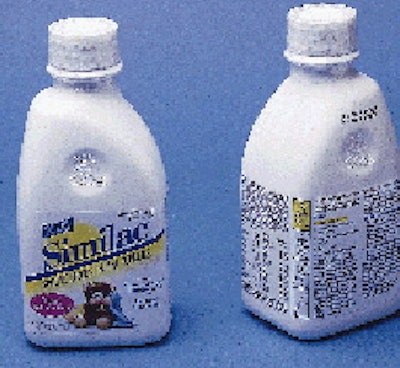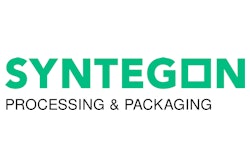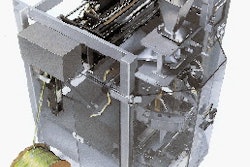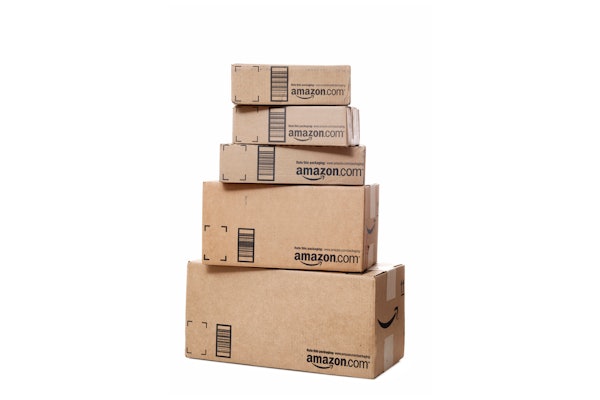
Most interesting is what we believe is the first low-acid aseptically filled plastic bottle to hit the retail market.
Earlier this summer, Mead Johnson Nutritional (Evansville, IN) announced the introduction of single-serve stick pack pouches of Enfamil Easy One powdered infant formula (see PW, July '98, p. 2) in its annual report. The stick packs are long, slim pouches holding just enough mix to make a single 4-oz bottle of formula with the addition of water. The pouches are marketed in 18-count paperboard cartons.
Convenience is the underlying packaging rationale for Enfamil Easy One. Mead Johnson notes on its web page meadjohnson.com that "each slim, durable easy-open packet pours neatly into the neck of a typical baby bottle, so there's no spilling or measuring of powder - and no worries about freshness." Mead Johnson is volunteering no packaging specifics about the stick pack. But Japanese machinery maker Sanko, represented in the U.S. by T.H.E.M. of New Jersey (Mt. Laurel, NJ), makes form/fill/seal equipment suitable for producing stick-packs just like Mead Johnson's. So it's likely Mead Johnson and T.H.E.M. of New Jersey are partnering on this development.
A more remarkable technological packaging achievement in infant formula is the current rollout by Ross Products Div., Abbott Laboratories, Inc. (Columbus, OH) of Similac ready-to-feed infant formula in aseptically filled, shelf-stable plastic bottles. Produced by Continental Plastic Containers (Norwalk, CT), the new coextrusion blow-molded bottles comprise high-density polyethylene/ethylene vinyl alcohol/HDPE that gives the milk-based formula a nine-month unrefrigerated shelf life.
For several years now, Ross has been experimenting with shelf-stable plastic containers for its infant formula and adult nutritional supplements. Earlier this year (see PW, March '98, p. 96), Ross introduced its Ensure nutritional milk shakes in polypropylene/EVOH/PP cups that are aseptically filled. And, since 1994, its in-hospital marketing program has included 2-oz retorted PP/EVOH/PP bottles of formula for newborns.
The new, quart-size bottles of Similac (see photo) are believed to be the first low-acid, aseptically filled, shelf-stable plastic bottles in the U.S. retail market. As with previous Ross consumer product introductions, the new aseptic Similac bottles are available exclusively at Wal-Mart stores.
While the multilayer plastic bottles consist of an EVOH barrier layer sandwiched between opaque white layers of HDPE (and therefore might have carried a "7/Other" resin identification code), they are coded simply "2/HDPE" to encourage recycling. Bottles are triple-sealed with a polyolefin/aluminum foil cap similar in appearance to the crimp-on caps of some yogurt cups but more difficult to remove. A 43-mm pp closure with foamed polymer liner provides secure reclosure, and a tamper-evident polyvinyl cholride band is shrunk over the closure. The band is perforated for easy removal and carries a pattern-printed Ross "R" logo around its circumference.
Aseptic filling is handled on Container Aseptic bottle filling systems from Robert Bosch Corp., Packaging Machinery Div. (Bridgman, MI). The equipment-believed to be the only aseptic bottle filler approved by the U.S. Food & Drug Administration for low-acid foods-can accept containers in the 50- to 1500-mL range at speeds of up to 100/min.
Bottles carry nine-month "use by" ink-jet codes. Product and brand identity, directions for use and a four-step sequential schematic for product use are four-color reverse printed on a shrink label converted by Salem Label Co. (Salem, OH). The label stock is Roll-on, Shrink-on (ROSO) coextruded PP from Mobil Chemical Co., Films Div. (Pittsford, NY). Copy on the label urges consumers after opening the bottles to "replace cap, refrigerate and use within 48 hours."
Extrusion blow-molded by CPC, the patented bottle design features one sloped shoulder, a rectangular footprint and a pair of sidewall finger dimples to facilitate pouring. Similac's "teddy bear with blanket" icon is embossed in the dimples to make the bottle easier to grip.
Ross' shelf-stable, aseptic Similac bottles represent the culmination of years of development work and are among the early examples of a generation of packaging achievements whose technical success depends, in part, on food processing advances that work with packaging material and machinery technologies.
In the next few years, a wide range of bottled and jarred beverages and foods will appear in shelf-stable, aseptic plastic containers. When they do, they'll owe a lot to the pioneering packaging work of Ross Laboratories.
'Portable yogurt' debuts in pouches
"Squeeze it, Slurp it, Grab it, Glurp it!" That product-mantra-cum-directions-for-packaging-use should be enough to tell you that Go-Gurt portable yogurt from the Yoplait Div., General Mills, Inc. (Minneapolis, MN) isn't your father's dairy confection.
In fact, Go-Gurt, "the Grab-n-Go Yogurt," is packed in tear-open single-serve "fridge or freeze" film tubes. The tubes (see photo) resemble freezer pop pouches and are designed to appeal to Yoplait's target market: active, on-the-go kids. Launched in Seattle, Go-Gurt pouches are packed in eight-count embossed foil cartons and stocked in refrigerated dairy cases in the western half of the U.S. plus Michigan, Indiana and Ohio.
The three-side-seal 11/2 X 83/4" notched-for-opening film tubes hold 2.25 oz of yogurt and run on vertical form/fill/seal pouching lines from Winpak Lane, Inc. (San Bernadino, CA). Go-Gurt's top, bottom and side-seal pouch structure uses 10% less material than the four-side-seal pouches from which European kids have been slurping yogurt for years. The U.S. pouches are made from a linear low-density polyethylene/polyester structure converted by Curwood, Inc. (Oshkosh, WI). Color-keyed by flavor, the pouches feature front panels with reverse printed, cartoon-style images of kids playing sports. Back panels carry required ingredient, UPC and company contact information that parents are likely to look for.
The moisture-resistant foil/paperboard Go-Gurt cartons are produced by Jefferson Smurfit Corp. (St. Louis, MO). They hold eight pouches of yogurt and also rely on comic-book graphics to appeal to the kids and identify the various two-flavor pouch combinations: Strawberry Splash/Berry Blue Blast; Red Raspberry/Paradise Punch; Strawberry Banana Burst/Watermelon Meltdown; Strawberry Kiwi Kick/Chill Out Cherry. Glurping is obviously a utensil-free experience; the Go-Gurt cartons carry "no spoon needed" blurbs on both front and top panels.


























